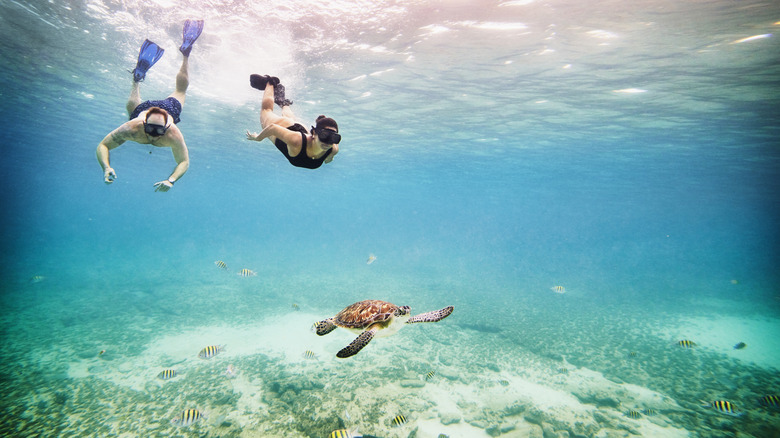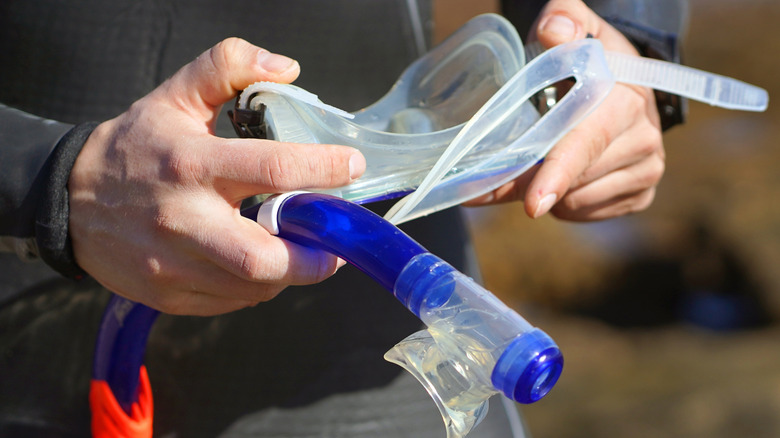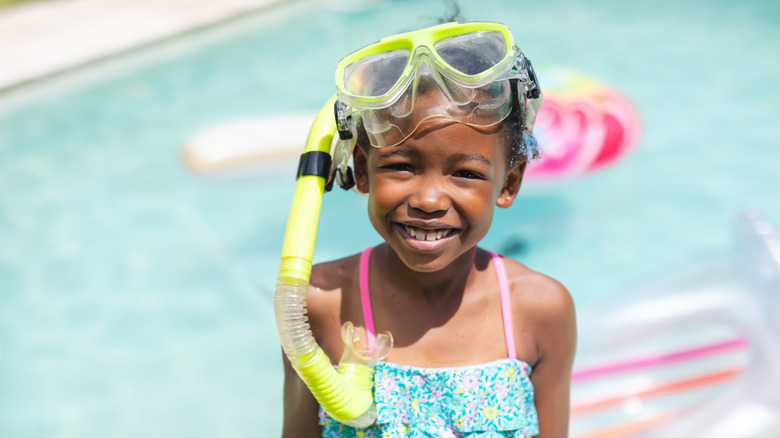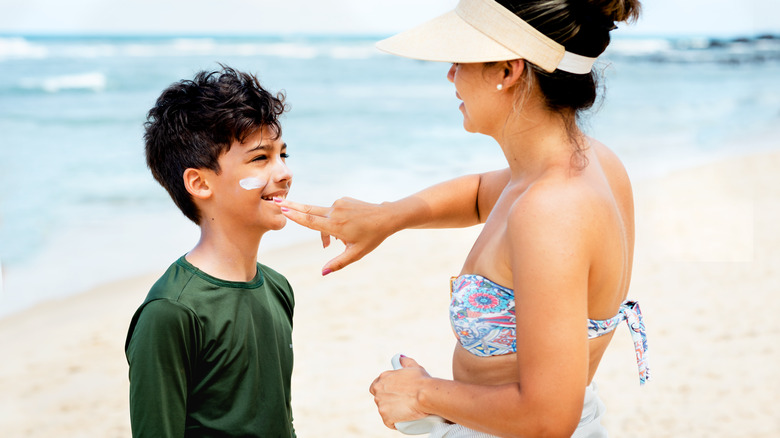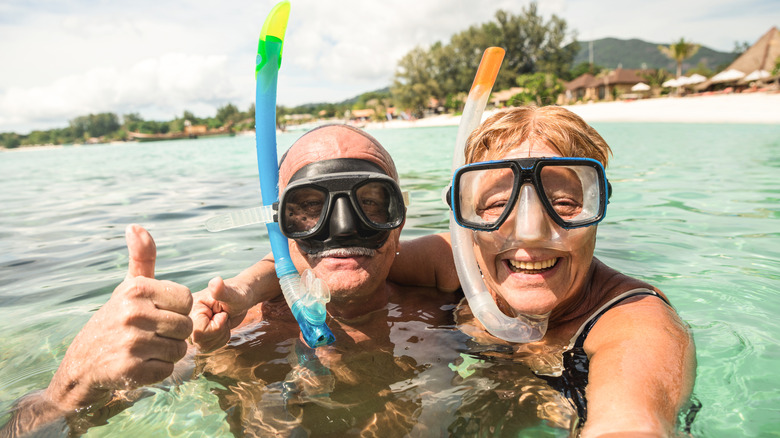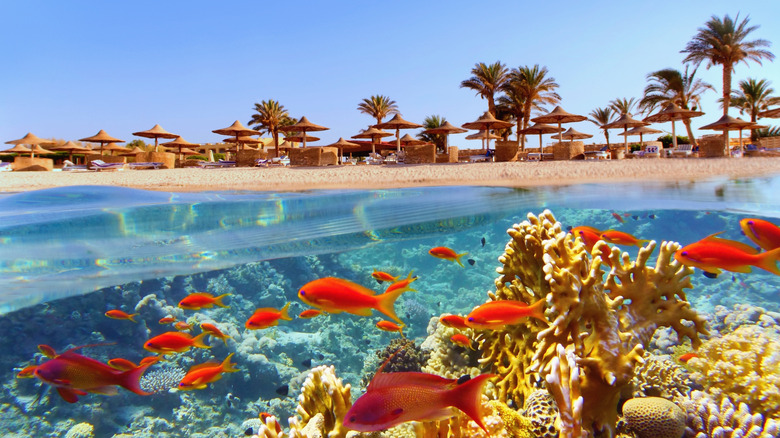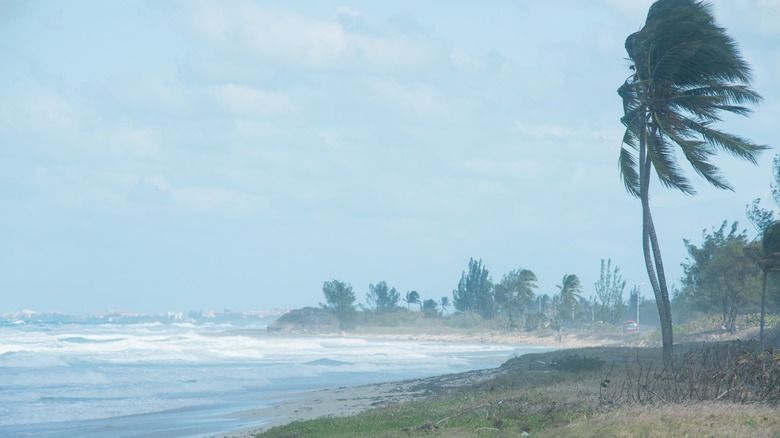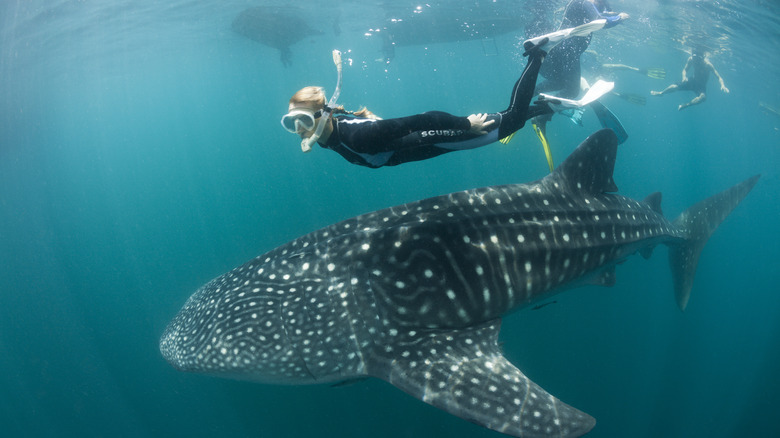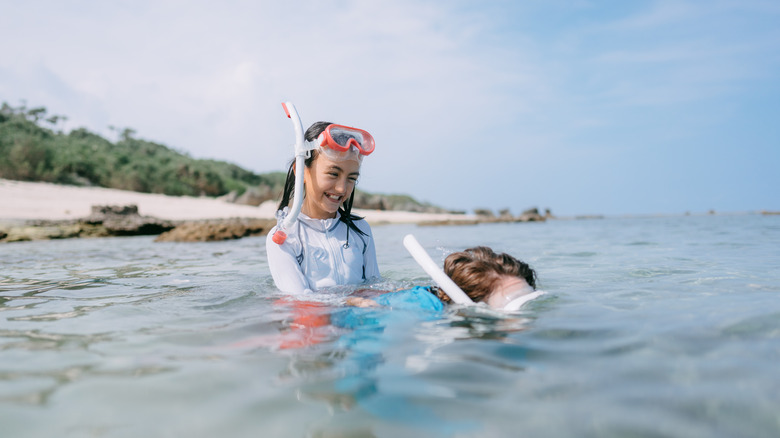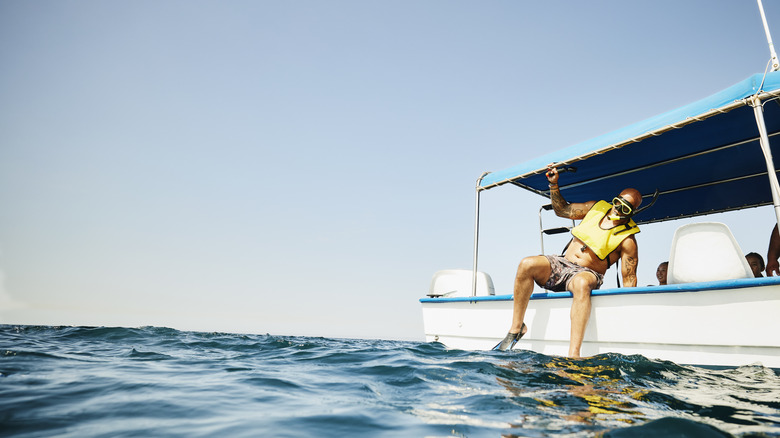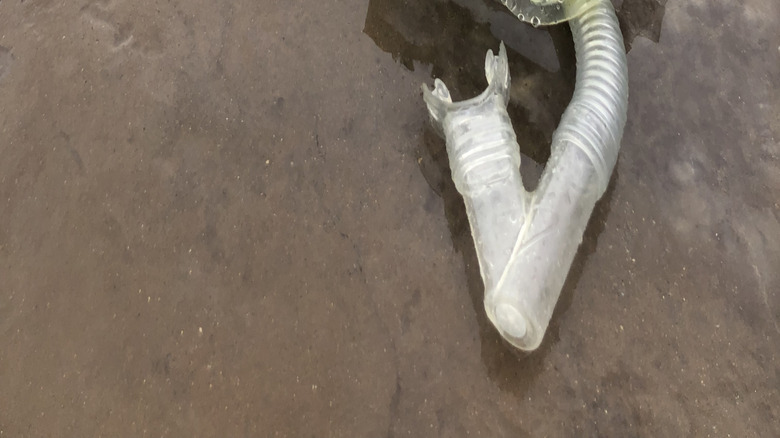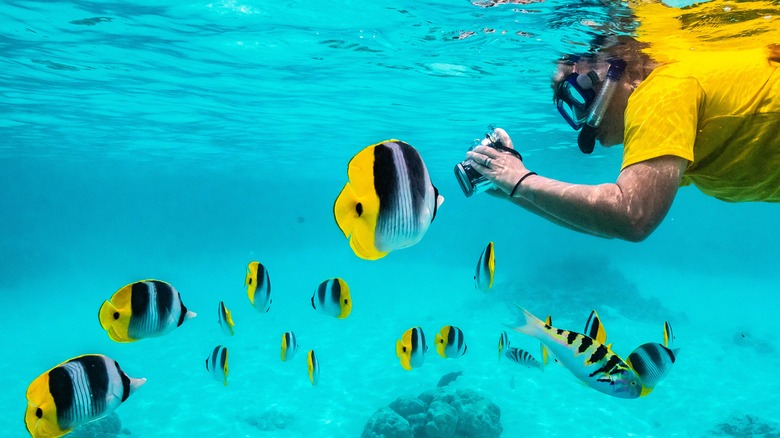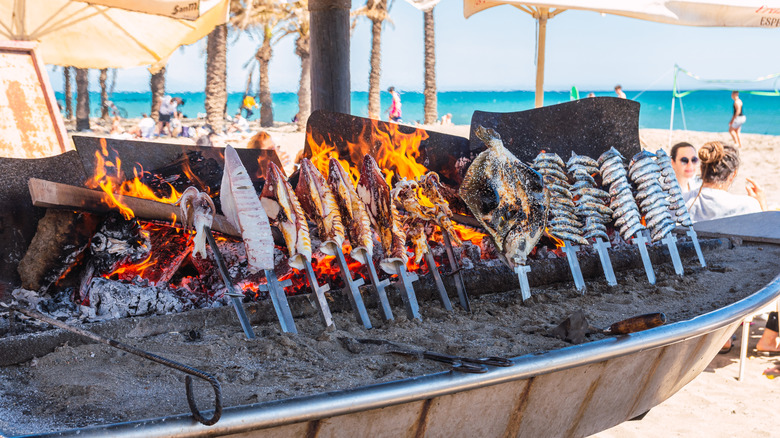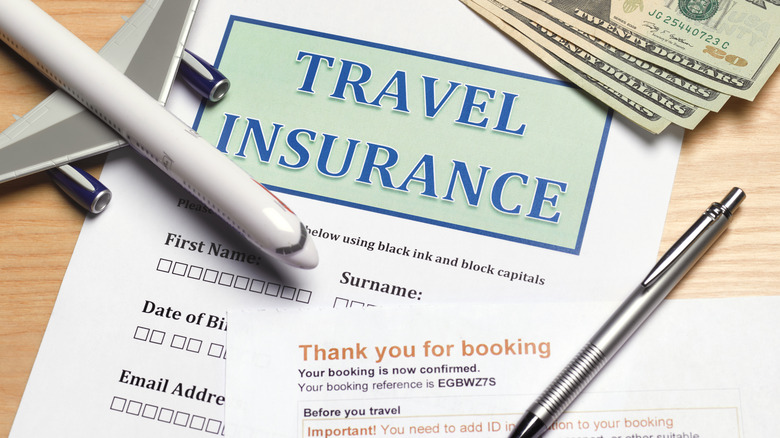14 Steps To Plan The Perfect Snorkeling Vacation
While some travelers like to explore the variegated terrain of the land, it's easy to forget that there is another world waiting under the surface of the sea. In waters all over the globe, an entirely different daily existence plays out, one where fish school in giant huddles, dolphins cavort in the shallows, and whales traverse vast distances across oceans and seasons. Many adventurers like to dive to explore these marine riches, but this requires training, stringent safety checks, and limitations on the time spent underwater.
Snorkeling, in a sense, is a much simpler experience — you just need to strap on the right gear, slide into the water, and you're good to go. And with snorkeling, the only restriction placed on your time (apart from the hours of sunlight) is how much energy you have. Snorkeling is a fun, easy, low-impact way to get a window onto an alien world.
Planning a trip, whether you are visiting the world's best islands for snorkeling or a secret destination, requires some careful thought and plenty of diligence. Having snorkeled on five continents, I know what it takes to get it right, and I'm here to help you plan that dream snorkeling vacation. Let's go!
1. Buy your own gear
Let's say you are going on a hiking expedition, maybe even an adventure to tackle the most challenging national park trails. You wouldn't borrow someone else's boots, would you? By the same logic, if you are planning to spend a lot of time in the water, it is crucial to take your own gear. Snorkeling can feel awkward, almost uncomfortable, and all your usual points of reference are upended. Balance is altered, breathing requires apparatus, and the feeling of being tethered to anything vaguely stable is absent.
With all that in play, it's important that you have gear that you know fits you (this cannot be stressed enough) and can perform as you need it to. One of the most deflating things about snorkeling is when there is plenty of marine life to see, but constantly failing gear denies you from seeing it, whether it is a mask whose apron isn't supple letting in water, fins that are too big slipping off your feet, or ones that are too small making your feet ache. If any of these issues arise when you are in the water, they will need to be addressed. Having to deal with these equipment issues will detract from what you should be doing, which is looking at the miraculous world underwater. If you rent an Airbnb that promises to provide snorkel gear onsite, don't be seduced by that amenity; chances are the items won't come close to your own set.
2. Practice beforehand
Snorkeling can be a magnificently strange experience. You may be floating on the water's surface, but half of your body is submerged below sea level. You face downwards, looking for movement below, and rely on a hard plastic tube to allow your lungs to access precious oxygen. The first few times you try it, the sensation can be incredibly unnerving. Some people feel like they are suffocating because the system of breathing seems alien. When you get water in your snorkel, the fear and feeling become all too real. But as with anything, it gets easier with practice, and that is the key: Practice.
If you are new to the experience — be sure to check out our primer for snorkeling newbies — or have bought new gear, getting accustomed to the process of snorkeling and your gear is crucial. It can help you make adjustments, feel comfortable breathing with your mouth and nose underwater, and ascertain whether this is the thing for you well before you lay out a ton of cash on a snorkeling vacation. It is good to practice in a large body of water, such as the sea, a lake, a pond, or even a big swimming pool, but even putting on a mask and snorkel in the bathtub can be beneficial. Every little helps.
3. Bring all the essentials
In any great movie, the stars only shine with a good supporting cast. For snorkelers, the main gear of the mask, snorkel, and fins are critical, and they are the stuff that will allow you to spend hours in the water admiring the magical aquatic world. However, the ancillary items — the supporting cast if you like — will ensure your snorkeling vacation goes off without a hitch. Sunblock is vital, as not only does the water reflect UV light (the stuff that can damage the skin), but sand also does, and you can quickly burn in the sun. Ideally, you should get reef-friendly sunblock, a product that doesn't contain chemicals harmful to coral or marine life.
A head covering or diving hood is also a great idea, as it will protect your neck and head from the strong rays of the sun. This can be particularly useful if you have a thin head of hair (or none at all). Similar logic informs the reason to wear a full-sleeved rash vest. If the water is in the slightest bit cool, consider bringing a wetsuit, which will stop you from getting cold quickly and allow you to snorkel for longer. They can also help keep you buoyant, as will a float vest (which is better for warm weather), meaning you will need to expend less effort to stay on the surface. Finally, think of wearing neoprene socks so your fins don't rub on your feet, and bring anti-fog liquid to stop your mask from misting up underwater.
4. Don't snorkel alone
Divers are always supposed to dive with a buddy. This is a basic safety measure to ensure that if one diver gets into trouble, the other is there to assist. There is no similar stipulation for snorkelers, but it is a much safer experience if you snorkel with someone else. Of course, it doesn't have to be just one other person; it can be as many as you like. The main thing is not to be alone.
While snorkeling is a relatively safe activity where the chance of serious injury is much lower than with diving, problems still occur. When they do, it is reassuring to know that you don't have to deal with them alone. When booking your trip, think about who will be going with you and whether you will have a snorkeling buddy on your excursions into the water. On a purely practical level, two sets of eyes looking into the water will always see more than one pair.
5. Choose the right destination
This might be the most important step when gauging the overall success of your vacation, and we're not just talking about snorkeling. Where are you going to go? It helps to start by asking yourself a few simple questions. Do you want to travel near or far, maybe to the best snorkeling spots in Asia? Would you prefer to go to a place where English is widely spoken (or another language you are familiar with), or does it not matter?
Are you only interested in locations that can be reached by a direct flight from your nearest airport, or are you happy to take a connecting flight or two as long as the snorkeling is worth the journey? These questions will help you to narrow down your choices significantly. For instance, if you prefer to stay within the country, perhaps try out some of the best snorkeling destinations in the U.S. There is magnificent snorkeling all around the globe; it's up to you where you want to go.
6. Pick the right time of year
Choosing the right time of year is arguably just as important as the choice of destination. For many parts of the United States, the weather varies wildly throughout the year. A destination that gets feet of snow in the winter can also have hot, sticky, humid summers, where the mosquitoes fly in thick swarms and are merciless. These different weather patterns will almost certainly impact your decisions and opportunities for snorkeling.
For example, if you may have your mind set on visiting some of the best snorkeling spots in the Bahamas, you are best off going to the islands from December through May. This allows you to avoid the Atlantic hurricane season, which runs from June through November. The Eastern Pacific hurricane season also runs around the same time, though it starts a couple of weeks earlier. However, if you want to snorkel in the Caribbean but can only get time off in August, you might want to consider these islands safe from hurricanes.
7. Decide if you want to experience something specific
Sometimes, you might want to snorkel for the fun of it, but you are just as likely to want to experience something specific, and this can impact a number of other steps in your planning process. Your motivations for snorkeling will influence your choice of destination and the time of year that you go. For example, is it your dream to snorkel with a whale shark? If so, Florida is an option — especially the Keys — but not the best choice, as spotting tends to be infrequent. For much better chances of snorkeling alongside the world's largest fish, these are the best places to swim with these giant creatures.
However, if you are hoping to share the water with a particular animal, you will need to visit at a particular time of the year, and these often coincide with migration patterns. Tourists who want to snorkel with humpback whales should consider the Dominican Republic, as the huge mammals congregate in a sanctuary called Silver Bank (usually from January to April each year). If that is on your bucket list, now you know when to book the trip.
8. Start slowly
Snorkeling is a low-impact pastime, and it can look pretty easy to a casual observer. After all, what do you have to do but just loll about in the sea and look down under the surface? When you first see the water, there is the temptation to immediately dive in. But letting your emotions take control can come back to bite you. You should always take time to scope out the conditions and get comfortable in the water. Feel the temperature, get a handle on any currents or undertow, and look for hazards in the water, like rocks, coral near the water surface, and urchins.
It is also important to remember that snorkeling is not a race. While snorkeling can seem like it doesn't require travelers to expend much energy, the exertion of being in the water can sneak up on you. If there is a current, you will need to kick to fight against it or move with it and hope to get back to where you need to be. Either way, the physical effort can easily tire your legs. And even if the water is warm, it can sap your body heat with assassin-like efficiency — some estimates suggest that water extracts heat from the body 25 times more quickly than air, so it won't take long before you can start to feel chills.
9. Do you want shore or boat access?
Before you get into the water, you need to work out exactly how you are going to access it. For some, snorkeling directly from the shore is the most appropriate option, while others will choose to head out in a boat and find an suitable spot. The latter option will come with an added cost and tack on extra expenses to your budget, but sometimes that's the price of a perfect place. It's worth taking some time to think about which access method you prefer.
Of course, there is always the option of doing both. Choosing a destination that matches your needs will get your vacation off on the right foot, so do some research ahead of time — there are plenty of blogs that detail snorkeling spots for any destination imaginable. For instance, Aruba has many snorkeling hotspots that can be accessed directly from beaches, including the coral at Mangel Halto, and the turtles at Boca Catalina. As ever, it all comes down to personal preference.
10. Have snacks handy
That should be a basic rule of life, right? As we've noted, snorkeling can be surprisingly tiring, and few things can ruin a great snorkeling excursion than getting out of the water totally spent, thirsty and hungry, and not having anything to hand. Fueling up between your episodes in the water will keep you in tip-top shape and ensure you don't succumb to fatigue, cramps, dehydration, or a general lack of vigor. Protein and energy bars are a good idea, though they can easily melt in hot conditions.
More stable options are nuts, seeds, and trail mix. Fruit like bananas, oranges, and pineapple can give you a boost, while watermelon can help with hydration and remove the salty taste of seawater. Always have lots of water or isotonic drinks on hand, or order fresh coconut water from a beach vendor if one is available. Rehydration is critical, as the heat can really dry you out.
11. Be flexible in your plans
As with any activity that requires being outdoors in an unsupervised location, snorkeling doesn't always work out. An area where you want to paddle around might be too crowded to make it an enjoyable experience, or the weather conditions might not be right on the day you visit. In that case, you can either try to make the best of the situation or wait until things improve. You might be waiting for a long, long time.
You might also be wedded to the idea of only snorkeling in sites accessible from the shore, but realize that you don't have enough time to see all the highlights of a destination unless you take a boat tour. You never know what will happen. The point is that sometimes you have to make new plans to replace your old ones, but that doesn't mean conceding defeat. You should look at it as a new opportunity, not a missed chance.
12. Take a camera
Some people are lucky enough to have photographic memories and can remember precise details of get-togethers and meet-ups, no matter how much time has elapsed. For us mere mortals, memories tend to be a little more fuzzy. Whichever camp you fall into, it is nice to have physical reminders of things that you saw on your snorkeling trip. Sure, those memories might be locked in your brain, ready to be summoned whenever you want, but seeing those images on a camera or relayed onto a bigger screen is a bonus that is hard to put into words.
In a way, photographic reminders can help you recreate the sensation of being in the water, taking you right back to the vacation, in mind if not in body. On top of that, having footage of your excursions is also fabulous for bragging rights and worth showing off to family and friends. Invest in a waterproof camera or one that can be put in a secure, watertight housing. Don't just plop your phone in a Ziploc bag and shoot with that; it's a poor substitute, and who knows what damage it will do to your phone.
13. Are you going just to snorkel?
So, you've decided to go on a snorkeling vacation, where being in the water is the main focus of the trip, but you won't be exploring the waters during every second of your holiday. Even if you've found a destination that satisfies your snorkeling desires, it is definitely worth finding a location that offers you other things to do. Maybe one of the days on your trip will have unpleasant weather, and you will have no option but to seek alternative activities.
Suppose you plan on cooking your own meals during your vacation. In that case, large, well-stocked supermarkets are key to your vacation. Being out in the wilderness, away from shops and markets, might not be ideal. If eating out is more important to you, you'll have to find a location with options, from seafood restaurants by the water to places serving grilled fish and meat on the beach. Furthermore, will you be looking for a night on the town after a day out on the water? Think about what other things you'll need from the destination in addition to the snorkeling. If you don't, and you get to the location and find it's missing what you want, no amount of incredible snorkeling will make up for it.
14. Think about travel insurance
Sometimes things go wrong, and travel insurance can be your knight in shining armor. If you pick the right policy, you could be safeguarded against all sorts of potential adventure problems. Say that you have booked the trip, but you or someone in your party falls ill before departure, and the trip must be postponed or even canceled. Maybe your flights are messed up, and you get to your destination a day late, incurring the expense of one night's lodging even if you aren't there. Or, during the trip, you suffer a nasty coral cut and have to incur some medical expenses. Without focusing on the negatives, the potential for problems really is endless.
Insurance can help you in these situations by reimbursing you any lost costs or fees incurred that are beyond your control. Of course, travelers always need to read the fine print and ensure that their claims fall within specific guidelines. Having a policy can not only offer you peace of mind; it can help you recoup a financial loss when things go awry. As the old adage goes, it is better to be safe than sorry.
